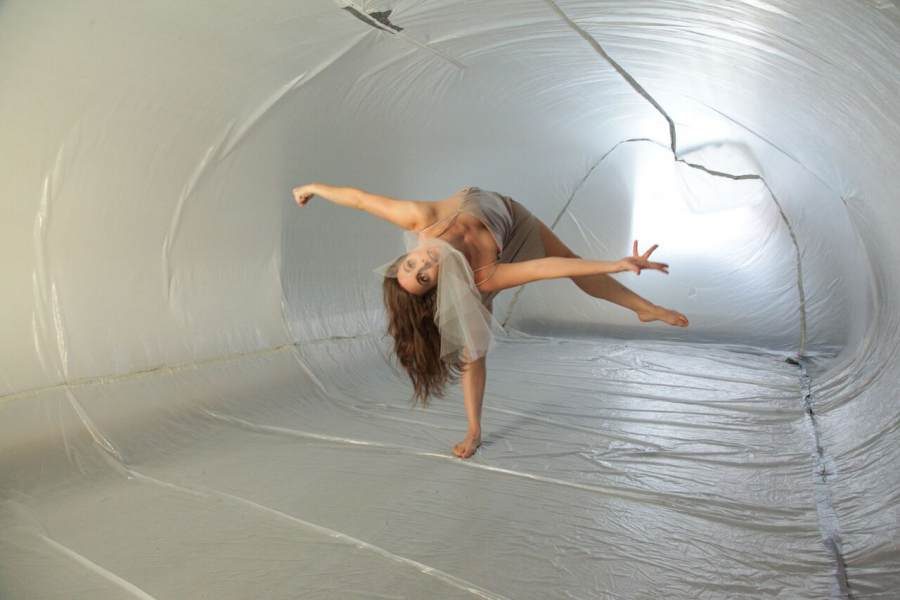

Triskelion Arts presented The Moving Architects from November 30 to December 2, 2017. The evening consisted of four works -- two live performance and two video -- that cycled through sociopolitical and elementally informed movement explorations. The works, directed by choreographer Erin Carlisle Norton and performed by six dynamic women, shaped Triskelion into a shifting prism, protest, micro-inspection of water pathways, and the aftermath of a depleted landscape. The evening was a journey of complex emotions and realities that the audience could relate to at least once.
Point of Contact (2017) is a concisely constructed video project. A high, revolving camera reveals writhing bodies on a black floor. The dancers squirm, slither, and navigate through the various opportunities of exposing skin to the ground below and the oscillating camera above. The stage illuminates spontaneously to expose a live performance of a soloist executing similar floor-based movement. I became quickly enthralled by this micro-investigation. Often we find movement studies becoming overly complex when one singular idea sufficiently explores the true intent of the work. Carlisle Norton successfully filtered the impetus of the work -- exposing circular, low movement through varying degrees of light and a bird’s eye perspective. The images on the screen coalesced and melted into the live performance -- the relationship not causal but more relative or respective to a common trajectory. I was transfixed by the image of a light-reflecting gem exposing the endless edges and juts of its surface.
Canon (2017) spoke to the audience through the lens of political and social protest. Before beginning, Carlisle Norton addressed the audience and distributed a booklet of illustrations depicting the front and back of picket signs. “Black Lives Matter,” “Resist Resist Resist,” and similar phrases echoed throughout the pages. The performance began with the women moving in and out of stillness. While stationary, signs were raised towards the audience. They were blank, allowing for our own thoughts after viewing the booklet and reflecting on current affairs. The signs were routinely rotated among the dancers -- is this a changing of perspective or “passing of the torch”? Though I was fascinated in the movement vocabulary -- the women vacillated between contorted balances, punctuated juts of energy, and supple articulation of the limbs -- I had questions about the connection between the signs and the movement. In light of police brutality against communities of color and Trump’s presidential win, protests erupted nationally, but these were not always contained. I attended many of these proudly, and the levels of participation ran the gamut, but emotions were always high. Is Canon presenting both sides of the activist: the anger and direct action of protest presented in the movement and peaceful defiance when standing with signs? Was the purpose to show that both can coincide?
Deep Water (2017) depicts six women adorned in flowing, cream-colored garbs traversing water pathways in manmade structures. Adaptations of the pas de bourrée and smaller step patterns carry the dancers around an emptied underground pool, reliving a circular current no longer there. Dancers slide and splash against the walls of a public shower, revitalizing an environment once alive with thousands of falling droplets. The six women hang from the side of the pool, embodying the residue of dripping water long dried up. The video was lethargic with few transitions and little camera movement. I was distracted by the quality of the film -- a dull hue accompanied each event -- and minimal editing. A shuffling dancer could be seen out of the camera’s focus preparing to reenter the space. Nonetheless, there was a lucid intent and delivery and the dancers were engaging.
The evening ended with America Dawn (Part 1) (2017), an ensemble work of dancers and live accompaniment. Inside the program for the audience to read was Thomas John Carlisle’s poem "America Dawn," which served as the inspiration for the dance. I did not read the poem -- I wanted to experience the performance without influence -- but now that I have, I feel my assumptions were concurrent with the poem’s theme. It describes an ambiguous stance on the modern city -- a thriving metropolis of hope yet a failing capitalist endeavor. My take on the performance was more the latter: a dark, sullen holding place for broken, disregarded litter. A wave of translucent plastic floods and encompasses the stage and overcomes a dancer; her previously defined silhouette becomes distorted by the light and plastic. The discordant musical score was beautifully eerie and instigated a feeling of emptiness. The dancers moved in tandem with the ebb and flow of volume and intensity, their costumes (seeming as resemblant of plastic as well) bouncing and encumbering their moving bodies. They appeared as the embodiment of waste or the cogs of the capitalist machine. Either way, their existence originates from the constructed environment; the fine details within a world of dissonance. I am interested to see the remaining iterations and further integration of Carlisle’s modern city.